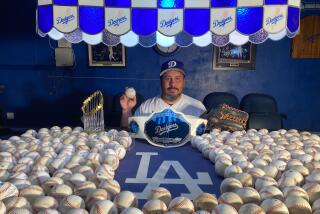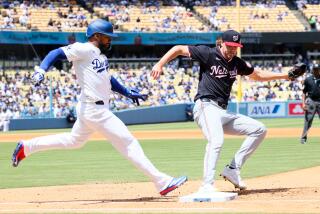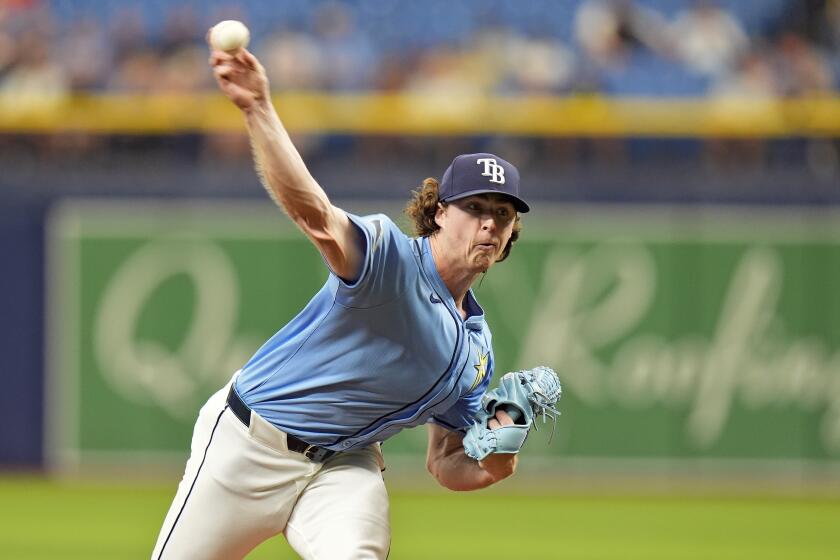Column: At trade deadline, Cubs ask ‘If not now, when?’ And the Dodgers?
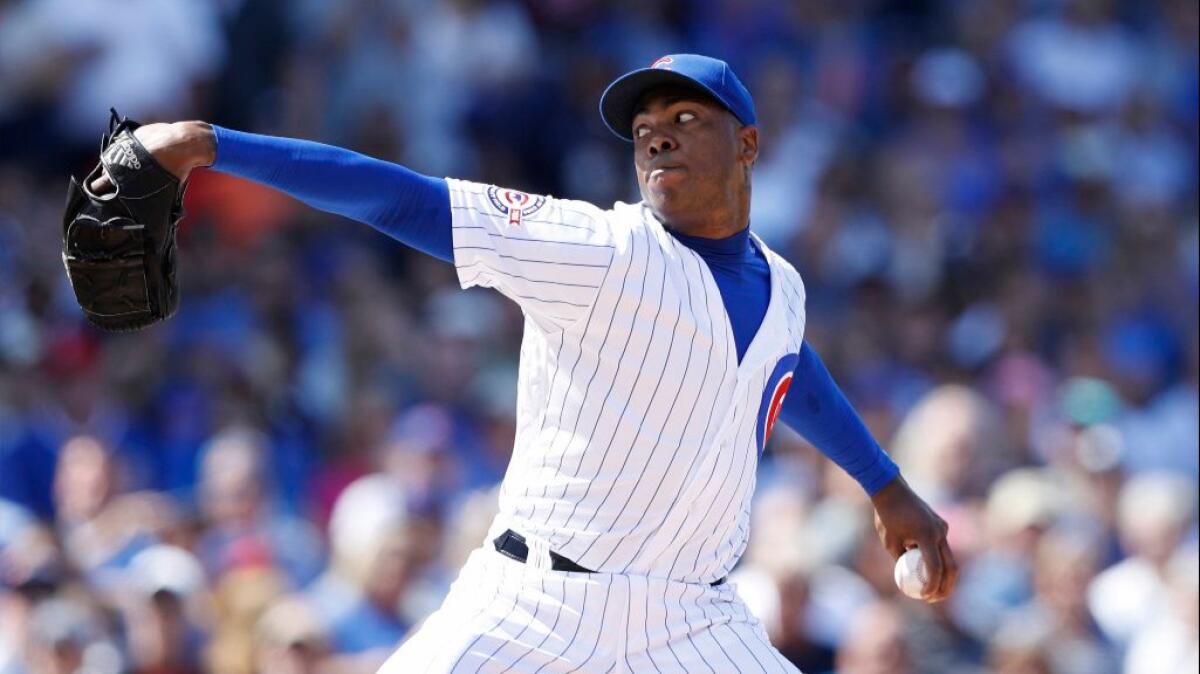
Mark Walter, the chairman and controlling owner of the Dodgers, lives in Chicago. He is a huge baseball fan, and the owner of season tickets for Chicago’s favorite team.
He stayed until the end of the Cubs’ 8-1 victory over the Chicago White Sox on Wednesday, and he was rewarded with a ninth inning in which the Cubs unveiled their grand prize from the trade market. Aroldis Chapman got all the oohs and aahs from a crowd that watched the closer throw a scoreless inning in which his first pitch was clocked at 101 mph and his last at 103 mph.
“He,” Walter said with a smile, “is good.”
The Cubs, mind you, have the best record in the major leagues. When they acquired Chapman on Monday, they had lost one game all season when leading after eight innings. Whatever their issues might be, the ninth inning is not one of them.
See the most-read stories in Sports this hour »
The Cubs still surrendered their top prospect to get Chapman, even though he might walk away as a free agent after the season.
“If not now, when?” Theo Epstein, the Cubs’ president of baseball operations, told reporters. “This was the appropriate move, given where we are and what we are trying to accomplish.”
That last part is no secret. The Cubs electrified their clubhouse and fan base by getting Chapman, in pursuit of their first World Series championship since 1908.
Walter said he did not believe the Dodgers needed to make a similarly dynamic trade to enliven their fan base — or their clubhouse, where players are increasingly skeptical that the front office will make a major deal to upgrade the roster.
“I think we’re doing fine,” Walter said. “If any other team had the injuries we had, they wouldn’t even be close, I don’t think.”
That is a ringing endorsement of Andrew Friedman, the Dodgers’ president of baseball operations, who has leveraged the team’s financial resources to amass depth more than star power. The Dodgers have lost more games to injury than any team in baseball, and still the National League West is theirs for the taking.
But this ought to be more of an all-in year for the Dodgers than the Cubs. Before they acquired Chapman, the Cubs roster did not include any significant players eligible for free agency this fall. The everyday lineup includes more players under 25 than over 30.
No matter how many young players a team collects, and how many years of control over those players, the best-laid plans can be derailed by injury or underperformance, or both. The Cubs see a parade in their grasp, and they acted accordingly.
The Dodgers? If not now, when?
Their All-Star closer, Kenley Jansen, will be a free agent this fall. So will their top home run hitter, third baseman Justin Turner. They do not appear to have one player they trust as an everyday outfielder. Their regular lineup includes more players over 30 than under 25.
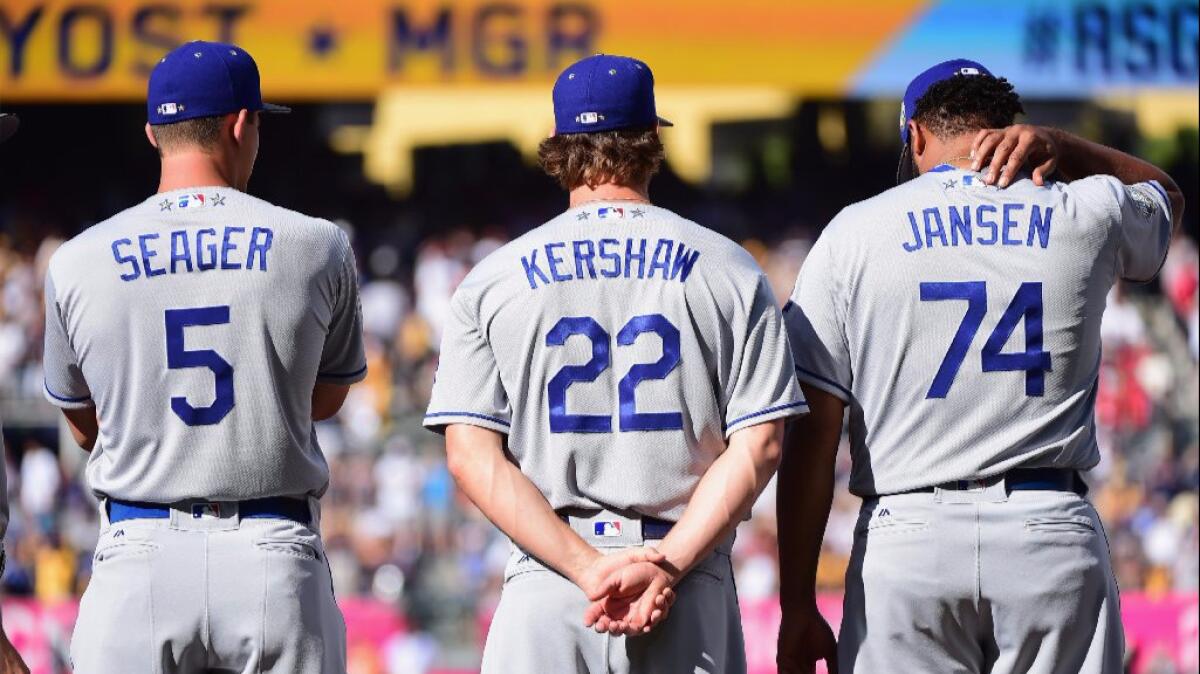
Clayton Kershaw, the best pitcher in baseball, has missed the last five weeks because of a herniated disk in his back. There is some hope Kershaw can return in another five weeks or so, around the time major league rosters expand and minor leagues shut down. But Kershaw would be building back his endurance all through September, so he might not be able to give the Dodgers more than five innings when he first returns.
He could come back strong next year. He could opt out of his contract the year after.
By Monday’s deadline, Friedman could come back from trade shopping with an outfielder, a relief pitcher, maybe a reliably healthy arm for the starting rotation. But he has said he is focusing on “elite-level players,” and frankly that ought to mean a starting pitcher for whom seven innings is an expectation, not a celebration.
The most prominent targets are Chris Sale of the White Sox and Chris Archer of the Tampa Bay Rays.
If, for Sale, the White Sox were to demand Julio Urias and Jose De Leon — the Dodgers’ two best minor league arms and two of the top 25 prospects in baseball — one Dodgers veteran said it should be a “no-brainer” for L.A. to do that deal. But the White Sox reportedly want five prospects in a trade for Sale, no doubt emboldened by a free-agent class in which the best starters available this off-season might be Andrew Cashner and Jorge De La Rosa.
It is entirely possible that the White Sox decide not to trade Sale, that the Rays decide not to trade Archer and that the New York Yankees decide not trade elite reliever Andrew Miller. So it is entirely possible, then, that Friedman could shrug and say, “Hey, I tried, but the elite players did not move.”
There is a lesson here. The lesson is not that Walter should refrain from rooting for the Cubs; trust us, he roots harder for the Dodgers and signs the checks to prove it. The lesson is not that the Dodgers should have gotten Chapman, who served a 30-game suspension for violating baseball’s domestic-violence policy. The Dodgers properly backed away from Chapman last off-season and did the right thing in staying away now.
The lesson is that elite starters were readily available last year, when the Dodgers held their prospects to their bosom and passed on David Price, Cole Hamels and Johnny Cueto, and when the Dodgers drew the line at spending an extra $50 million on Zack Greinke.
You never know. Chapman blew a save opportunity for the Cubs on Saturday. But it would be painfully unfortunate if the Dodgers front office ends up pursuing elite talent this year only to realize that “If not now, when?” was the question they should have asked last year.
Follow Bill Shaikin on Twitter @BillShaikin
More to Read
Get our high school sports newsletter
Prep Rally is devoted to the SoCal high school sports experience, bringing you scores, stories and a behind-the-scenes look at what makes prep sports so popular.
You may occasionally receive promotional content from the Los Angeles Times.
